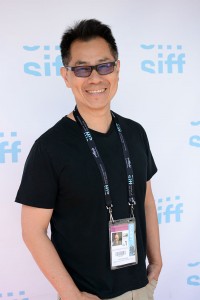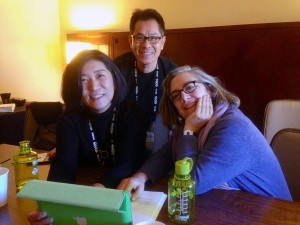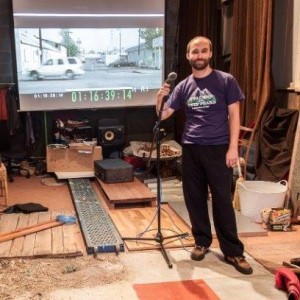Library of Congress, August 2017
 The Library of Congress has selected The Killing Fields of Dr. Haing S. Ngor for their permanent collection of films that demonstrate long-term significance for future researchers and the public. Official selections for the collection exemplify the wide range of U.S. film productions and reflect the diversity of American thought and experience.
The Library of Congress has selected The Killing Fields of Dr. Haing S. Ngor for their permanent collection of films that demonstrate long-term significance for future researchers and the public. Official selections for the collection exemplify the wide range of U.S. film productions and reflect the diversity of American thought and experience.
DVD and VOD Release, October 2016
 The Killing Fields of Dr. Haing S. Ngor is now available on DVD and VOD. Special bonus features include the original trailer and the music video featuring Bochan performing the film’s love theme Like a Rose.
The Killing Fields of Dr. Haing S. Ngor is now available on DVD and VOD. Special bonus features include the original trailer and the music video featuring Bochan performing the film’s love theme Like a Rose.
U.S. Broadcast Premiere, September 2016
Khmer Version in Production, November 2015
ARVE Error: src mismatch
url: https://vimeo.com/146954492
src in: ?dnt=1
src gen: https://player.vimeo.com/video/146954492?dnt=1Actual comparison
url: https://vimeo.com/146954492
src in:
src gen: https://player.vimeo.com/video/146954492
Best Documentary Feature Award, Sep 2015

The Cambodia Town Film Festival bestowed its inaugural Best Documentary Feature Award to The Killing Fields of Dr. Haing S. Ngor. The Jury noted: “Our selection committee received a number of submissions and your work was unanimously praised for its many cinematic strengths.”
Cambodia Film Tour, Aug 2015
 The U.S. Embassy Phnom Penh, Cambodia and Bophana Center are proud to present the international Cambodia premiere of The Killing Fields of Dr. Haing S. Ngor. The four city tour includes stops in Phnom Penh, Battambang, Siem Reap, and Dr. Ngor’s hometown, Samrong Yong in Takeo. Director Arthur Dong will be in attendance at all screenings. August 21–28, 2015.
The U.S. Embassy Phnom Penh, Cambodia and Bophana Center are proud to present the international Cambodia premiere of The Killing Fields of Dr. Haing S. Ngor. The four city tour includes stops in Phnom Penh, Battambang, Siem Reap, and Dr. Ngor’s hometown, Samrong Yong in Takeo. Director Arthur Dong will be in attendance at all screenings. August 21–28, 2015.
Full Houses in Cambodia, Aug 2015
 The four-city Cambodia tour played to full houses at each stop, with over 2,000 in attendance. The screenings presented an opportunity for Cambodians and others to better understand the Khmer Rouge era, as this tragic yet significant part of the country’s history is not currently part of the curriculum in Cambodian schools. View photos here: https://goo.gl/wbas0S
The four-city Cambodia tour played to full houses at each stop, with over 2,000 in attendance. The screenings presented an opportunity for Cambodians and others to better understand the Khmer Rouge era, as this tragic yet significant part of the country’s history is not currently part of the curriculum in Cambodian schools. View photos here: https://goo.gl/wbas0S
New York Premiere, Jul 2015
 The Big Apple welcomed The Killing Fields of Dr. Haing S. Ngor with a full house as part of the 38th Asian American International Film Festival’s tribute to director Arthur Dong. In attendance were, l-r: Sophia Ngor, Arthur Dong, Wayne Ngor, Pat Golden, and Jack Ong. Ms. Golden was the casting director of The Killing Fields who discovered Haing Ngor in 1983 for the film that led to his Oscar® win.
The Big Apple welcomed The Killing Fields of Dr. Haing S. Ngor with a full house as part of the 38th Asian American International Film Festival’s tribute to director Arthur Dong. In attendance were, l-r: Sophia Ngor, Arthur Dong, Wayne Ngor, Pat Golden, and Jack Ong. Ms. Golden was the casting director of The Killing Fields who discovered Haing Ngor in 1983 for the film that led to his Oscar® win.
Seattle Premiere, Jun 2015
 The Killing Fields of Dr. Haing S. Ngor made its Northwest premiere to an enthusiastic audience at the Seattle International Film Festival, receiving “best picks” recommendations from The Seattle Times, The Stranger, and SIFF artistic director, Carl Spence.
The Killing Fields of Dr. Haing S. Ngor made its Northwest premiere to an enthusiastic audience at the Seattle International Film Festival, receiving “best picks” recommendations from The Seattle Times, The Stranger, and SIFF artistic director, Carl Spence.
Audience Award, Apr 2015
 The Killing Fields of Dr. Haing S. Ngor took home the Best Documentary Audience Award at the Los Angeles Asian Pacific Film Festival. Audience awards, which are selected by viewers rather than by a jury, have become among the most important prizes granted at film festivals worldwide.
The Killing Fields of Dr. Haing S. Ngor took home the Best Documentary Audience Award at the Los Angeles Asian Pacific Film Festival. Audience awards, which are selected by viewers rather than by a jury, have become among the most important prizes granted at film festivals worldwide.
Los Angeles Premiere, Apr 2015

Post-screening Q & A (l-r): Wilson Wu, Grant Nellessen, Mark Adler, Arthur Dong, Asiroh Cham, Vanara Taing, Bochan, Yori Mochizuki
The Killing Fields of Dr. Haing S. Ngor played to a sold-out audience at the Los Angeles Asian Pacific Film Festival. Joining director Arthur Dong, center, for the post-screening Q & A were members of the crew. Bochan treated the audience with a performance of her song Like a Rose, which is featured in the film’s soundtrack.
Soundtrack Song, Apr 2015
 Cambodian American musician Bochan spent the week creating and recording special Khmer lyrics for her hauntingly beautiful song Like a Rose, for the soundtrack of The Killing Fields of Dr. Haing S. Ngor.
Cambodian American musician Bochan spent the week creating and recording special Khmer lyrics for her hauntingly beautiful song Like a Rose, for the soundtrack of The Killing Fields of Dr. Haing S. Ngor.
World Premiere, Mar 2015
Our world premiere took place at the historic Castro movie palace in San Francisco. Presented by CAAMFest 2015, special guests included director Arthur Dong, narrator Wayne Ngor, and subjects Sophia Ngor and Jack Ong. “Beautiful” was an accolade heard often from audience members; “riveting” and “powerful” was heard a lot too!

On the red carpet at the Castro Theater, San Francisco, l-r: Sophia Ngor, Arthur Dong, Wayne Ngor, Jack Ong. Photo by Young Gee, ©2015.

Funder Cal Humanities’ staff and board at the world premiere reception, l-r: Program Officer John Lightfoot, Development Officer Ann Yoshinaga, and Board Members Santhosh Daniel, Jeff Adachi, and Margaret Shellada, pictured with film Director Arthur Dong (front center). Photo by Bob Hsiang Photography, ©2015.
Sound Work Completed, Jan 2015

Sound designer and re-recording mixer Joe Milner at Puget Sound, Los Angeles. Photo by Arthur Dong, copyright 2014 DeepFocus Productions, Inc.
Our post-production sound team included Joe Milner, sound designer and re-recording mixer at Puget Sound; Miguel Barbosa, foley artist at Sound Troop; and foley mixer, Diego Suárez Staub. Miguel and Diego worked from Spain, while Joe was stationed in Los Angeles.

Working from Spain, foley mixer Diego Suárez Staub creates the sound of Lon Nol troops marching en masse.
Picture Lock, Nov 2014

Our editing team has locked picture and will now focus on the post-production sound. Editor Arthur Dong was assisted by Vanara Taing and Dan Myers.
Animation Voice Overs, Jul 2014

Cambodian genocide survivors Jonathan Nhean and Luon Um Nhean provide voices-overs. Photo by Arthur Dong, copyright 2014 DeepFocus Productions, Inc.
Survivors of the Cambodian genocide provided voice-overs for animated scenes that featured Khmer Rouge soldiers. Participants included Jonathan Dok, Jonathan Nhean, and Luon Um Nhean.

Cambodia genocide survivor Jonathan Dok provides voice-overs. Photo by Arthur Dong, copyright 2014 DeepFocus Productions, Inc.

Illustration from an animated scene with Khmer Rouge soldiers. Drawing by Yori Mochizuki. Copyright 2014 DeepFocus Productions, Inc.
Sundance Fellowship, Jan 2014

Director Arthur Dong consults with Sundance editorial advisors Jean Tsien, left, and Carol Dysinger on The Killing Fields of Dr. Haing S. Ngor.
Arthur Dong was selected for a Fellowship by the Sundance Documentary Program to attend the 2014 Sundance Film Festival. The program invites directors of Sundance supported projects to represent their films at a series of curated one-on-one meetings with international documentary industry leaders and broadcasters.
The Script, Jun 2013

The Killing Fields of Dr. Haing S. Ngor scripts ready for production. © 2013 DeepFocus Productions, Inc., photo by Arthur Dong.
LOS ANGELES – A draft of The Killing Fields of Dr. Haing S. Ngor script has been completed! Filmmaker Arthur Dong wrote the full-length screenplay based on Dr. Ngor’s 500-page autobiography, some 300 pages of transcripts, over 30 hours of archival footage, television talk shows, news stories, extensive historical and background research, and consultation with a distinguished panel of advisors.
Animation Launched, May 2013

Storyboard detail from The Killing Fields of Dr. Haing S. Ngor. . © 2013 DeepFocus Productions, Inc., illustration by Yori Mochizuki
LOS ANGELES – We’re happy to announce that we’ve started on the storyboards of the animation scenes for The Killing Fields of Dr. Haing S. Ngor. Here you see Dr. Ngor under interrogation by a Khmer Rouge soldier. Our artist is the incredible Yori Mochizuki.
Voice Overs By Dr. Ngor’s Nephew, Apr 2013

Wayne Ngor records voice-overs for The Killing Fields of Dr. Haing S. Ngor.. © 2013 DeepFocus Productions, Inc., photo by Arthur Dong.
NEW YORK CITY – Dr. Ngor’s nephew, Wayne Ngor, recorded voice-overs for The Killing Fields of Dr. Haing S. Ngor. In 1975, at the age of two, Wayne was forced into captivity by the Khmer Rouge regime, but eventually made it to America in 1996. Today, he proudly serves as one of NYPD’s finest. Read more about Wayne’s recording session.
The Killing Fields Casting Director, Apr 2013

The Killing Fields casting director, Pat Golden, and Arthur Dong. © 2013 DeepFocus Productions, Inc.
NEW YORK CITY – Pat Golden discovered Dr. Ngor in 1982 at a Cambodian wedding in Oxnard, California and cast him in The Killing Fields, his first film. Here she reminisces with Arthur Dong at a classic New York City coffee shop.
Khmer Rouge Tribunal, Oct 2012

Dr. Haing S. Ngor’s grandniece and grandnephew, Sokal and Oudom Bunna, join filmmaker Arthur Dong (center) at the Khmer Rouge Tribunal. © 2013 DeepFocus Productions, Inc.
PHNOM PENH – Haing Ngor’s grandniece and grandnephew, Sokal and Oudom Bunna, join filmmaker Arthur Dong (center) at the Khmer Rouge Tribunal. On that day, Khmer Rouge army regiment commander, Meas Voeun (inset), was on the witness stand and described his troops’ entry into Phnom Penh on April 17, 1975.
The Killing Tree, Oct 2012

Haing Ngor’s grandniece and grandnephew, Sokal and Oudom Bunna. At Choeung Ek Genocidal Museum, Phnom Penh. © 2013 DeepFocus Productions, Inc.
PHNOM PENH – “Killing tree against which executioners beat children” reads the sign at the Choeung Ek Genocide Museum, a former orchard where mass graves of Khmer Rouge victims were discovered. Pictured: Haing Ngor’s grandniece and grandnephew, Sokal and Oudom Bunna.
Dr. Ngor’s Hometown, Oct 2012

Dr. Haing S. Ngor’s former classmate, Chea Hai, at Ngor’s childhood home in Samrong Yong Village. © 2013 DeepFocus Productions, Inc.
SAMRONG YONG, CAMBODIA – Dr. Haing S. Ngor’s former classmate, Chea Hai, points out the site of Ngor’s childhood home in Samrong Yong Village (where the yellow house now stands).
Searching For Footage, Oct 2012

Archivist Sopheap Chea (l) assists Arthur Dong at the Bophana Audiovisual Resource Center, Phnom Penh. © 2013 DeepFocus Productions, Inc.
PHNOM PENH – Archivist Sopheap Chea (left) assists Arthur Dong at the Bophana Audiovisual Resource Center to locate historical footage on the Khmer Rouge.
Dr. Haing S. Ngor’s Archive, Jun 2012

The Dr. Haing S. Ngor Archive, Long Island, NY. © 2013 DeepFocus Productions, Inc., photo by Arthur Dong.
GLEN HEAD, LONG ISLAND – Pictured here are just some of the 48 boxes of material that chronicles Dr. Ngor’s life journey, including videos, photos, correspondence, and personal items that he hid and smuggled out of the Khmer Rouge labor camps.
The Hunt For Clues, Jun 2012

Dr. Ngor’s niece, Sophia Ngor, and Jack Ong, executive director of The Dr. Haing S. Ngor Foundation, at The Dr. Haing S. Ngor Archive. © 2013 DeepFocus Productions, Inc., photo by Arthur Dong.
GLEN HEAD, LONG ISLAND – Dr. Ngor’s niece, Sophia Ngor, who escaped Cambodia with her uncle, and Jack Ong, executive director of The Dr. Haing S. Ngor Foundation, inspect the actor’s belongings that they packed in 1996, after his murder in Los Angeles Chinatown.
A Sewing Kit Survives, Jun 2012

Dr. Ngor’s Sewing kit, an item from The Dr. Haing S. Ngor Archive. © 2013 DeepFocus Productions, Inc., photo by Arthur Dong.
GLEN HEAD, LONG ISLAND – Dr. Ngor’s sewing material that were used while in captivity under the Khmer Rouge are some of the very few possessions that he managed to hold on to while escaping Cambodia in 1979.




Follow Us